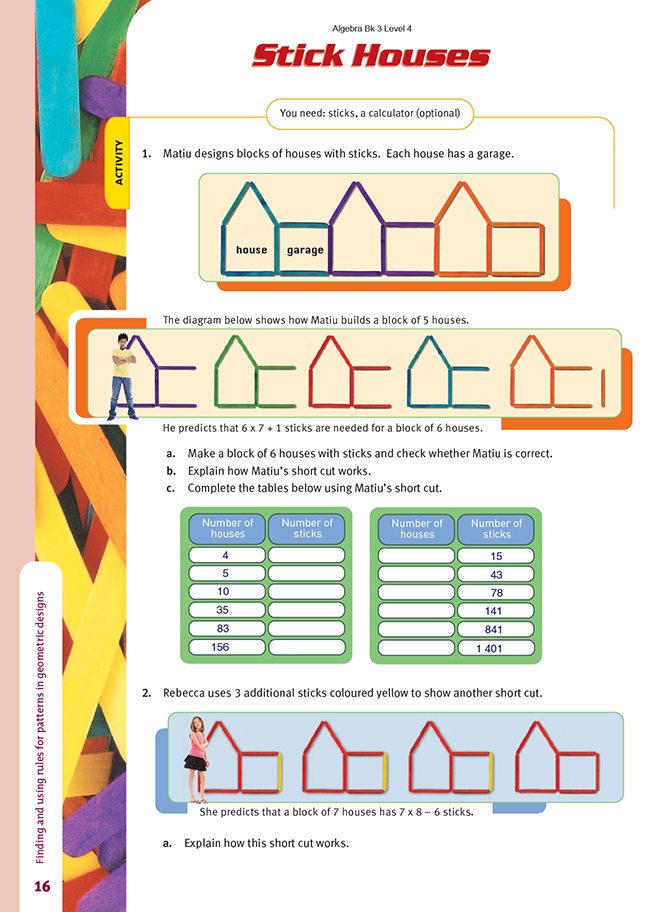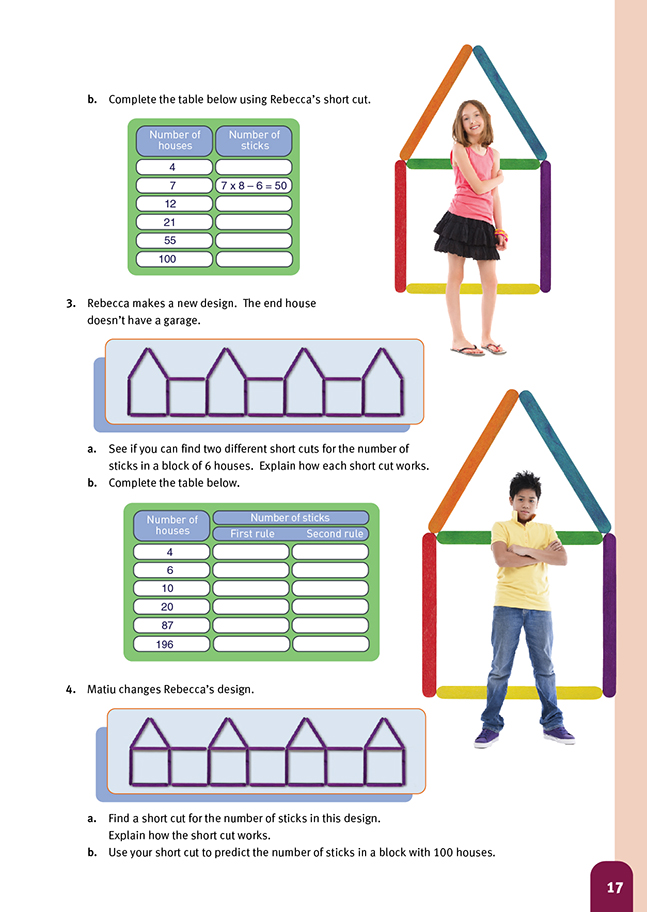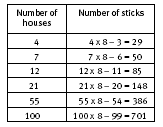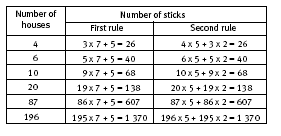This is a level 4 algebra strand activity from the Figure It Out series.
A PDF of the student activity is included.
Click on the image to enlarge it. Click again to close. Download PDF (312 KB)
use a table to find a rule for a geometric pattern
use a linear equation to describe the pattern
calculator (optional)
sticks
FIO, Level 4, Algebra, Book Three, Stick Houses, pages 16-17
In this activity, students base their short cuts and rules on the arrangements of sticks used in designs for blocks of houses.
In question 1, each house and its adjoining garage needs 7 sticks (5 for the house and 2 for the garage). An additional stick is needed for the end wall of the last garage. So, a block of 5 houses needs 5 x 7 + 1 = 36 sticks, and a block of 100 houses needs 100 x 7 + 1 = 701 sticks. A block of x houses therefore needs y sticks where y = x x 7 + 1 sticks. This is usually written as y = 7x + 1. A block with 1 000 houses
therefore needs 7 x 1 000 + 1 = 7 001 sticks.
In the second table in question 1c, the students need to reverse their thinking in order to find the number of houses for a given number of sticks. So, for example, if the number of sticks used is 78, we subtract 1 (the stick used for the final garage) and then divide by 7 to find the number of houses (11). This can be expressed as (78 – 1) ÷ 7 = 11.
In question 2, Rebecca first makes each house with its garage separate by including an extra stick for the vertical wall of all but the last garage.
.gif)
A block with 4 houses therefore needs 4 x 8 sticks. But when the houses and garages are joined, the extra 3 sticks are no longer needed. So there are 4 x 8 – 3 sticks altogether. A block with 100 houses therefore needs 100 x 8 – 99 sticks, and a block with x houses needs y sticks where y = x x 8 – (x – 1). This is the same as y = 8x – (x – 1).
Although the two algebraic rules for blocks of houses shown in questions 1 and 2 are different, they each produce identical values for y (the number of sticks) for particular values for x. Students who can manage the algebra above might check their rules by making the calculations in a table such as the following one.
.gif)
While the equivalence between the two algebraic expressions may seem obvious, it is helpful to confirm it in this way since the simplification of 8x – (x – 1) is often carried out incorrectly.
.gif)
Students who are puzzled by this will find it helpful if they investigate what has been done to make the first simplification incorrect and the second correct. They should convince themselves by checking the expressions for particular values of x.
In questions 3 and 4, the students devise their own short cuts and rules for the number of sticks in the designs. In question 3, they will be able to confirm their rule by completing the table for question 3b. The number of sticks for particular houses using any rule must be the same.
Two possible arrangements for the design in question 4 and their rules are shown below. The number of houses is x, and the number of sticks is y.
.gif)
So the simplest way to calculate the number of sticks for, say, 100 houses is 8 x 100 – 2 = 798.
Answers to Activity
1a.
![]()
A block of 6 houses has 6 x 7 + 1 = 43 sticks.
b. There are 6 sets of 7 sticks and an additional stick to complete the garage wall at the end of the block.
.gif)
2. a. A block of 7 houses would have 7 sets of 8 sticks or 7 x 8 sticks altogether. But the 6 yellow sticks used to complete the garage walls for 6 of the 7 houses will not be needed when the houses are joined. So we subtract 6 sticks. Therefore,
7 x 8 – 6 = 50 sticks are needed.
.gif)
b.
3. a. Answers will vary. A short cut for this design for a block of 6 houses is 5 x 7 + 5 = 40.
There are 5 houses using 7 sticks each and 5 sticks for the last house. Another short cut for this design is 6 x 5 + 5 x 2 = 40. There are 6 houses using 5 sticks each and 2 sticks for each of the 5 garages.
b. Answers will vary. Based on the short cuts in a:
4. a. Answers will vary. A short cut based on the design below is 3 x 8 + 6 = 30. There are 3 houses using 8 sticks each and 6 sticks for the last house.
b. 99 x 8 + 6 = 798





